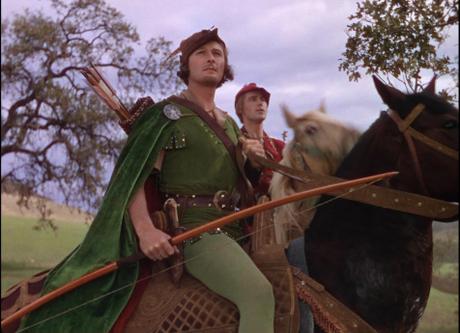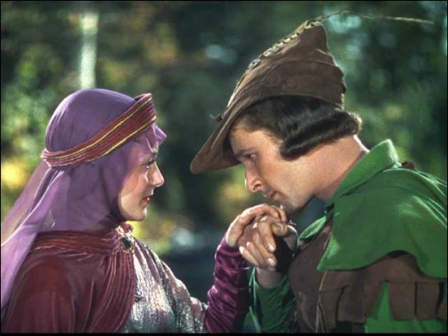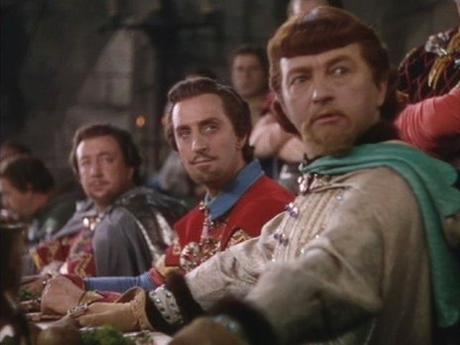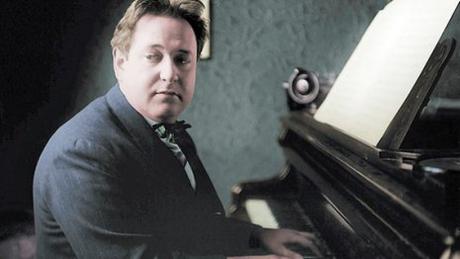 Robin Hood (Errol Flynn) & Will Scarlett (Patric Knowles) in The Adventures of Robin Hood
Robin Hood (Errol Flynn) & Will Scarlett (Patric Knowles) in The Adventures of Robin HoodThough filmed in the “wilds” of the California hills — in a 2400 acre natural park, to be exact, outside the town of Chico, California, near where the 1922 silent version was also shot — and originally conceived as a vehicle for movie tough-guy James Cagney, The Adventures of Robin Hood is considered by many movie buffs and film historians to be the classic rendition of the legend of Robin Hood and his merry band of outlaws.
It’s grand movie-making at its finest, which proved a box-office bonanza for the Warner Brothers studio at a time when the hounds of war were yapping at the heels of Europe — with many of the predominantly British and/or UK cast members sensing the difficulties their fellow countrymen abroad were about to undergo, what with the outbreak of World War II only a few short years away.
If not for the fact that Cagney’s contractual dispute with Warners and his subsequently walking out on the studio for a two-year period, the film might have taken on a completely different aspect with an American in the lead (as witness the egregious casting of Kevin Costner in the part a good half-century later). There had even been reports of a possible Nelson Eddy-Jeanette MacDonald musical version of the tale, to be produced by M-G-M and based (as the finished product was partially based) on the Reginald de Koven-Harry Smith 1890 operetta Robin Hood. This work is more widely known for the song, “Oh, Promise Me,” written by de Koven, with lyrics by English poet Clement Scott, in 1887 and inserted into the third act wedding scene by the actor playing Alan-a-Dale. The story goes that the actor, not happy with the tune he was given, demanded a showier platform for his talents, thus the inclusion of this most long-lived of wedding standards.
Viewers can thank the film gods, too, for M-G-M’s decision not to produce a musical take on the tale. Instead, all authorship rights to the original Robin Hood script by Rowland Leigh were sold to Warners with the condition that a straight, non-singing dramatic picture be made. So be it: Warners contract writers Norman Reilly Raine and Seton I. Miller were assigned the task of revising the script to conform to these new provisions.
As a result of these occurrences, a screenplay was worked out that borrowed heavily from all existing sources, to include bits and pieces from the de Koven-Smith version: for example, the rivalry between Robin and Sir Guy of Gisbourne for the hand of Maid Marian, now called Lady Marian. Casting was a major factor in the film’s success, and there are superb performances from just about every member of the group, especially the excellent Robin Hood of the youthful and athletic Errol Flynn, who was at his peak and never better in green tights. Olivia de Havilland, in her third pairing with the swashbuckling Flynn (their previous features included Captain Blood and The Charge of the Light Brigade), is the lovely Lady Marian.

Rumors of an infatuation surrounded both stars. Be that as it may, there is no record of an actual affair having transpired between them. Olivia, who had often played the goody-two-shoes in any number of productions, was hardly that in real life. But knowing of Flynn’s reputation with the ladies (and his recent marital troubles with the tempestuous Lili Damita), de Havilland rejected his advances. Nevertheless, their scenes together — flirtatious and tender, with a welcome touch of insouciance on both their parts — convinced viewers they were absolutely right for each other, at least as a screen couple. In all, they appeared in seven motion pictures together.
In other roles, character actor Claude Rains played the slightly effete but thoroughly malevolent Prince John, with Basil Rathbone as the slimy scoundrel Sir Guy of Gisbourne — and a fairly decent swordsman, at that. After Captain Blood, in which the South African-born actor had a bit part as a French pirate, Rathbone took up fencing as a sport and practiced it regularly on and off the set. For the film, he and Flynn were coached by fencing master Fred Cavens, with Flynn allegedly doing most of his own stunts.

Yeoman work was provided by Melville Cooper as the phlegmatic Sheriff of Nottingham; the boisterous Alan Hale, in a repeat of his earlier 1922 silent stint with Douglas Fairbanks, as Little John (he was to assume the role one last time in 1950’s Sword of Sherwood Forest); and bullfrog-throated Eugene Pallette as the rotund Friar Tuck (a part originally intended for Guy Kibbie). Others in the cast included Una O’Connor as Lady Marian’s lady-in-waiting Bess, Herbert Mundin as Much the Miller’s Son, Patric Knowles as Will Scarlett (another case of a part intended for another actor, i.e. David Niven), Ian Hunter as a model King Richard the Lion Heart, Montagu Love as the Bishop of the Black Canons, Ivan Simpson as the Proprietor of Kent Road Tavern, Lionel Belmore, Leonard Mudie, and many others in fine support.
The whole picture was exquisitely scored by Moravian-born composer and former child prodigy, Erich Wolfgang Korngold, for which he won a deserved Academy Award for Best Original Score. With the exception of Austrian composer Max Steiner, Korngold wrote the music for a total of seven of Flynn’s best features. However, according to film historians Tony Thomas and Rudy Behlmer, this one was “music creating an aura of heroism and romanticism.” Elegant and complex, his themes for Robin Hood were quite possibly, in the words of Korngold’s son, George Korngold, the “closest” he ever came to “creating an opera without singing, bolstering and carrying along the action with an almost uninterrupted stream of colorful music.”

The film was directed with flair and gusto by Michael Curtiz, who replaced the original director, William Keighley, because of his being over budget (the final tally reached $2 million dollars, the most expensive Warners picture to that time). Producer Hal B. Wallis’ continued impatience with Keighley’s slower-paced working methods also brought in second unit director, B. Reeves “Breezy” Eason, to move things along. Eason had previously worked with Flynn on The Charge of the Light Brigade, with Sol Polito and Tony Gaudio were in charge of the cinematography.
This is perfect family entertainment for all and lavishly filmed in early three-strip Technicolor. For adventure and romance, it has never been topped. The story of Robin Hood has been remade numerous times, with Cornell Wilde in The Bandit of Sherwood Forest (1946), Jon Hall in The Prince of Thieves (1948), John Derek in Rogues of Sherwood Forest (1950), Richard Todd in The Story of Robin Hood and His Merry Men (1952), Don Taylor in The Men of Sherwood Forest (1954), Richard Greene in Sword of Sherwood Forest (1960), Brian Bedford in the Disney animated feature Robin Hood (1973), Sean Connery as an over-the-hill bandit in Robin and Marian (1976), and, in recent times, Kevin Costner in Robin Hood: Prince of Thieves (1991), Patrick Bergen in Robin Hood (1991), Cary Elwes in Mel Brooks’ spoof Robin Hood: Men in Tights (1993), and the latest version with Russell Crowe, Robin Hood (2010), which is more in the nature of an origin story.
Copyright © 2015 by Josmar F. Lopes

